“The titan arum or Amorphophallus titanum (from Ancient Greek amorphos, “without form, misshapen” + phallos, “phallus”, and titan, “giant”) is a flowering plant with the largest unbranched inflorescence in the world. The titan arum's inflorescence is not as large as that of the Talipot palm, Corypha umbraculifera, but the inflorescence of the Talipot palm is branched rather than unbranched.
Due to its odor, which is reminiscent of the smell of a decomposing mammal, the titan arum is characterized as a carrion flower, and is also known as the “corpse flower”, or “corpse plant” (Indonesian: bunga bangkai – bunga means flower, while bangkai means corpse or cadaver). For the same reason, the title “corpse flower” is also attributed to the genus Rafflesia which, like the titan arum, grows in the rainforests of Sumatra.
The titan arum's inflorescence can reach over 3 metres (10 ft) in height. Like the related cuckoo pint and calla lily, it consists of a fragrant spadix of flowers wrapped by a spathe, which looks like a large petal. In the case of the titan arum, the spathe is green on the outside and dark burgundy red on the inside, and deeply furrowed. The spadix is hollow and resembles a large loaf of French bread. The upper, visible portion of the spadix is covered in pollen, while its lower extremity is spangled with bright red-orange carpels. The “fragrance” of the titan arum resembles rotting meat, attracting carrion-eating beetles and Flesh Flies (family Sarcophagidae) that pollinate it. The inflorescence's deep red color and texture contribute to the illusion that the spathe is a piece of meat. During bloom, the tip of the spadix is approximately human body temperature, which helps the perfume volatilize; this heat is also believed to assist in the illusion that attracts carcass-eating insects.
Both male and female flowers grow in the same inflorescence. The female flowers open first, then a day or two following, the male flowers open. This usually prevents the flower from self-pollinating.
After the flower dies back, a single leaf, which reaches the size of a small tree, grows from the underground corm. The leaf grows on a semi-green stalk that branches into three sections at the top, each containing many leaflets. The leaf structure can reach up to 6 metres (20 ft) tall and 5 metres (16 ft) across. Each year, the old leaf dies and a new one grows in its place. When the corm has stored enough energy, it becomes dormant for about 4 months. Then, the process repeats.
The corm is the largest known, weighing around 50 kilograms (110 lb). When a specimen at the Princess of Wales Conservatory, Kew Gardens, was repotted after its dormant period, the weight was recorded as 91 kilograms (200 lb)”. – Wikipedia
Due to its odor, which is reminiscent of the smell of a decomposing mammal, the titan arum is characterized as a carrion flower, and is also known as the “corpse flower”, or “corpse plant” (Indonesian: bunga bangkai – bunga means flower, while bangkai means corpse or cadaver). For the same reason, the title “corpse flower” is also attributed to the genus Rafflesia which, like the titan arum, grows in the rainforests of Sumatra.
The titan arum's inflorescence can reach over 3 metres (10 ft) in height. Like the related cuckoo pint and calla lily, it consists of a fragrant spadix of flowers wrapped by a spathe, which looks like a large petal. In the case of the titan arum, the spathe is green on the outside and dark burgundy red on the inside, and deeply furrowed. The spadix is hollow and resembles a large loaf of French bread. The upper, visible portion of the spadix is covered in pollen, while its lower extremity is spangled with bright red-orange carpels. The “fragrance” of the titan arum resembles rotting meat, attracting carrion-eating beetles and Flesh Flies (family Sarcophagidae) that pollinate it. The inflorescence's deep red color and texture contribute to the illusion that the spathe is a piece of meat. During bloom, the tip of the spadix is approximately human body temperature, which helps the perfume volatilize; this heat is also believed to assist in the illusion that attracts carcass-eating insects.
Both male and female flowers grow in the same inflorescence. The female flowers open first, then a day or two following, the male flowers open. This usually prevents the flower from self-pollinating.
After the flower dies back, a single leaf, which reaches the size of a small tree, grows from the underground corm. The leaf grows on a semi-green stalk that branches into three sections at the top, each containing many leaflets. The leaf structure can reach up to 6 metres (20 ft) tall and 5 metres (16 ft) across. Each year, the old leaf dies and a new one grows in its place. When the corm has stored enough energy, it becomes dormant for about 4 months. Then, the process repeats.
The corm is the largest known, weighing around 50 kilograms (110 lb). When a specimen at the Princess of Wales Conservatory, Kew Gardens, was repotted after its dormant period, the weight was recorded as 91 kilograms (200 lb)”. – Wikipedia
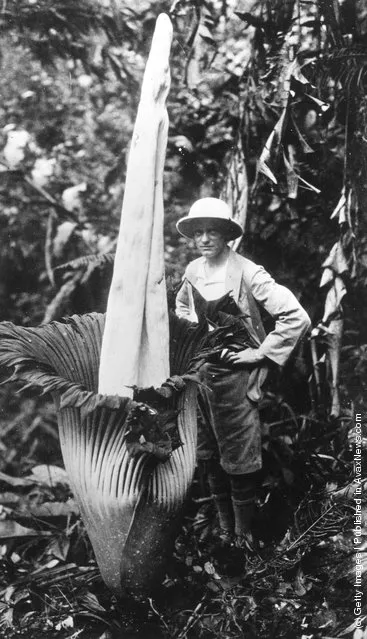
Amorphophallus Titanum, the world's largest flower in full blossom. (Photo by Hulton Archive/Getty Images). Circa 1940
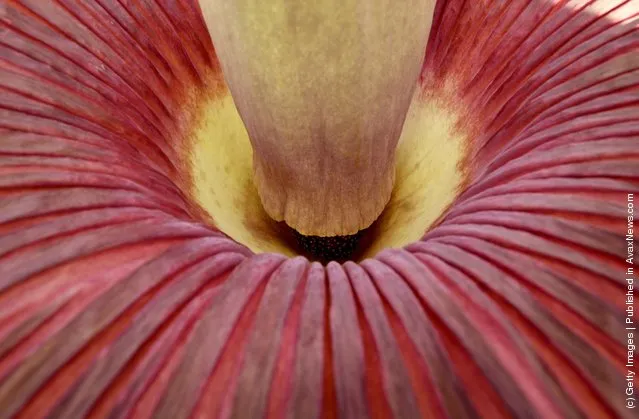
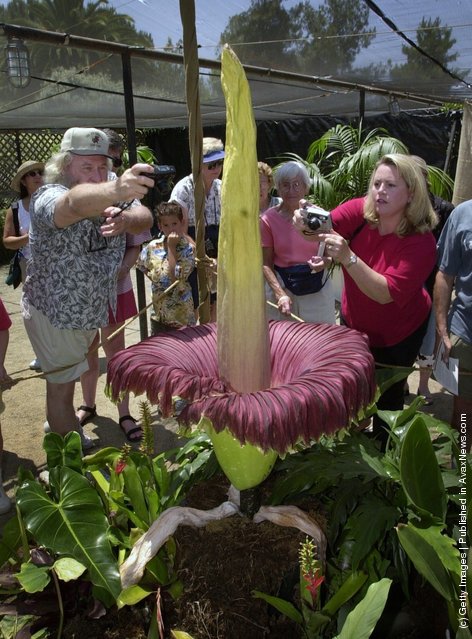
Visitors to the Fullerton Arboretum in Fullerton, CA, lean forward to take closeup pictures June 14, 2000 of a rare blooming corpse flower, or titan arum, which is known for it's powerful smell like rotting flesh. The corpse-like smell of the blooming plant from central Sumatra draws flies and other insects for pollination. It is one of about a dozen corpse flowers known to have bloomed in the United States in the past century. (Photo by David McNew/Newsmakers)

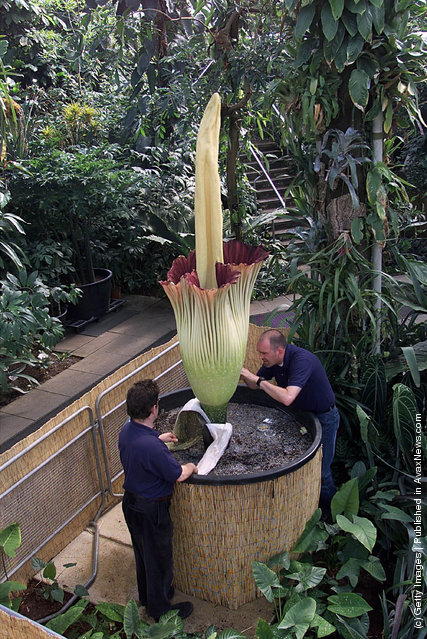
The world's largest and most pungent flower known as Amorphophallus titanum or the Titan Arum is shown May 2, 2002 in Kew Gardens, London. The flowering of this amazing giant of nature occurs very rarely. The flower shown has taken six years to flower and weighs approximately 200 pounds. (Photo by Graham Barclay/Getty Images)
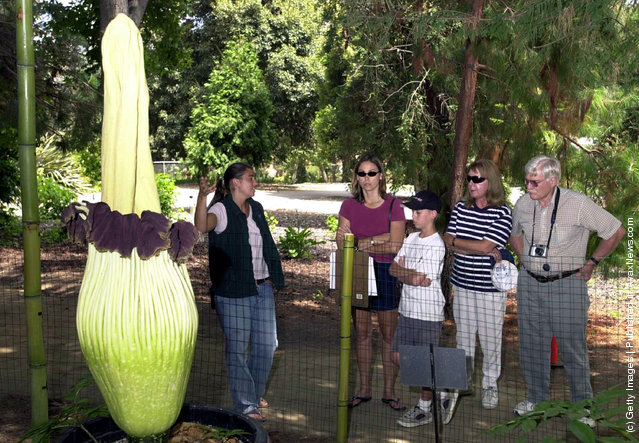
Intern Jennifer Drozd (L) shows visitors the world's biggest and stinkiest flower at the Quail Botanical Gardens July 18, 2002 in Encinitas, California. The Amorphophallus Titanum, or Titan Arum, blooms only a few times in its 40-year life span, and for eight hours, emits a nauseating odor to attract pollinating beetles. The blooming of the flower sometimes called the corpse flower drew large crowds to the botanical gardens. (Photo by Earl S. Cryer/Getty Images)
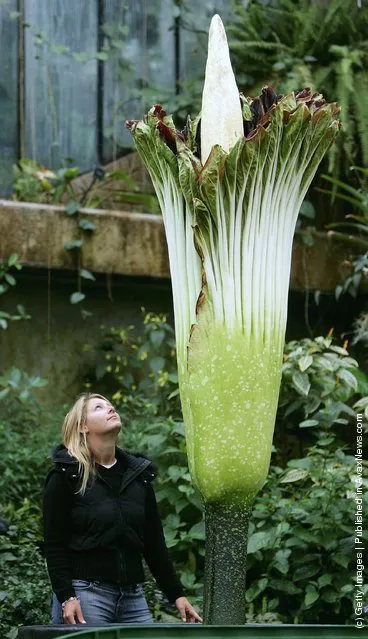
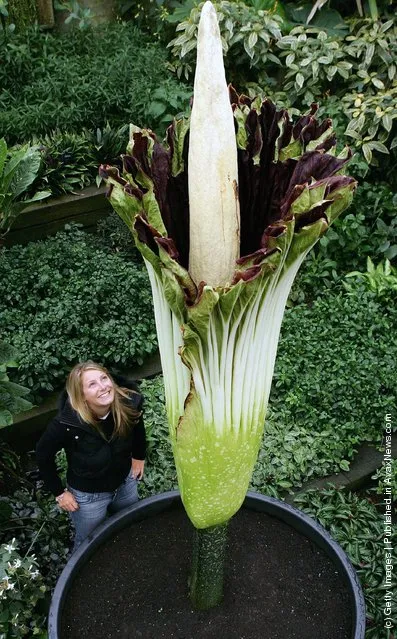
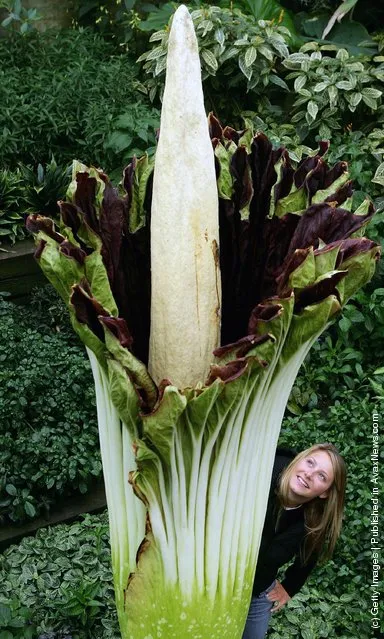
Kew Gardens employee Lauren Bird Royal examines the flowering of the Titan Arum lily at the Botanical Gardens at Kew on September 30, 2005 in London, England. For the first time in horticultural history, the Titan Arum lily can be seen at all three active stages in its lifecycle – in flower, fruit and leaf.The flowering corm is nearly three metres tall and weighs 91kg and is very rarely seen outside of the rainforests of Sumatra, Indonesia. (Photo by Scott Barbour/Getty Images)
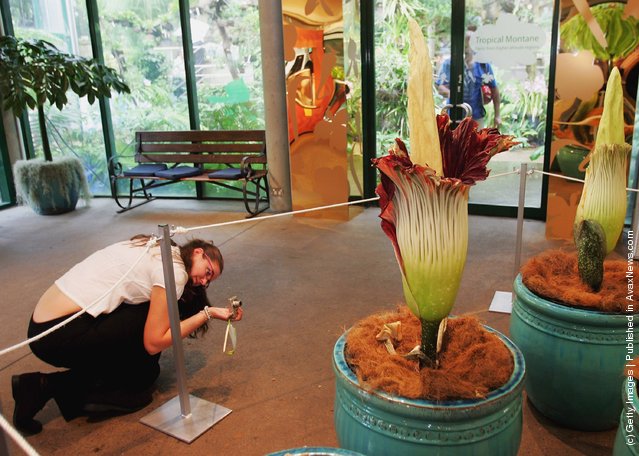
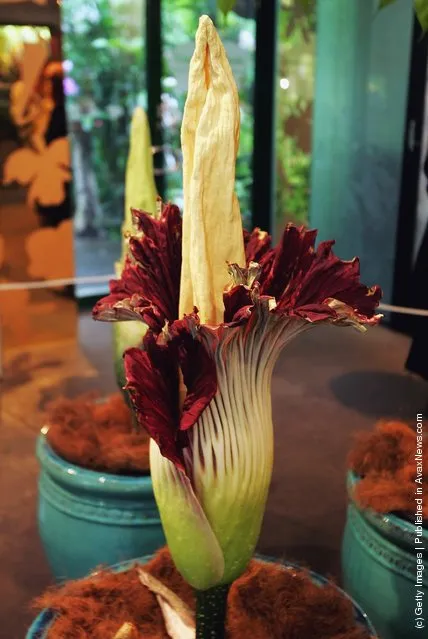
The Titan Arum (Amorphophallus titanum), also known as the Corpse Flower, on display at the Tropical Centre in the Royal Botanical Gardens in Sydney, Australia. The Titan Arum has the largest – and possibly the smelliest – flower in the world. The Botanic Gardens Trust is collaborating with the Indonesian Botanic Gardens to cultivate the species which is endangered in its natural habitat. (Photo by Ezra Shaw/Getty Images)
20 Sep 2011 11:13:00,
post received
0 comments
